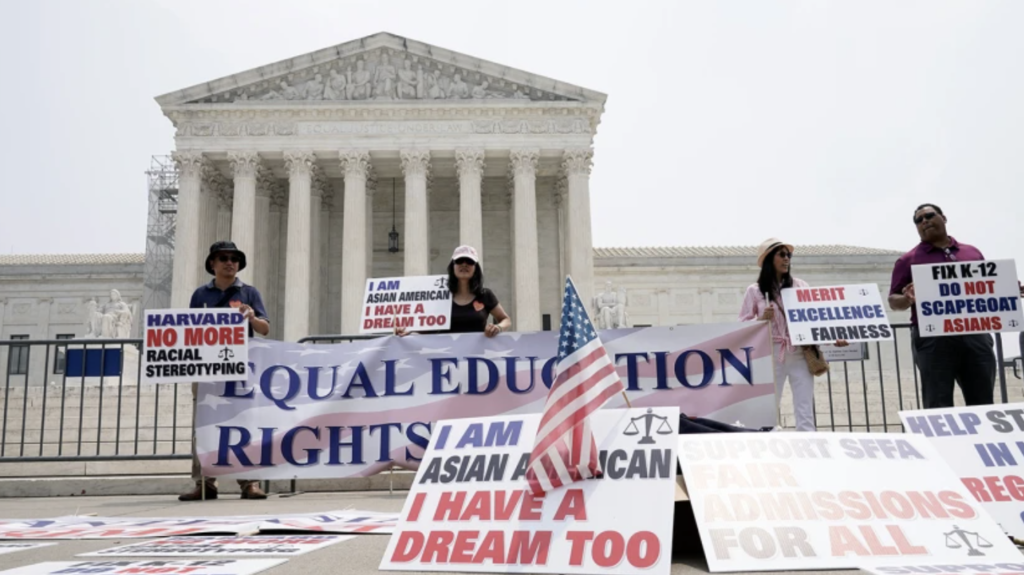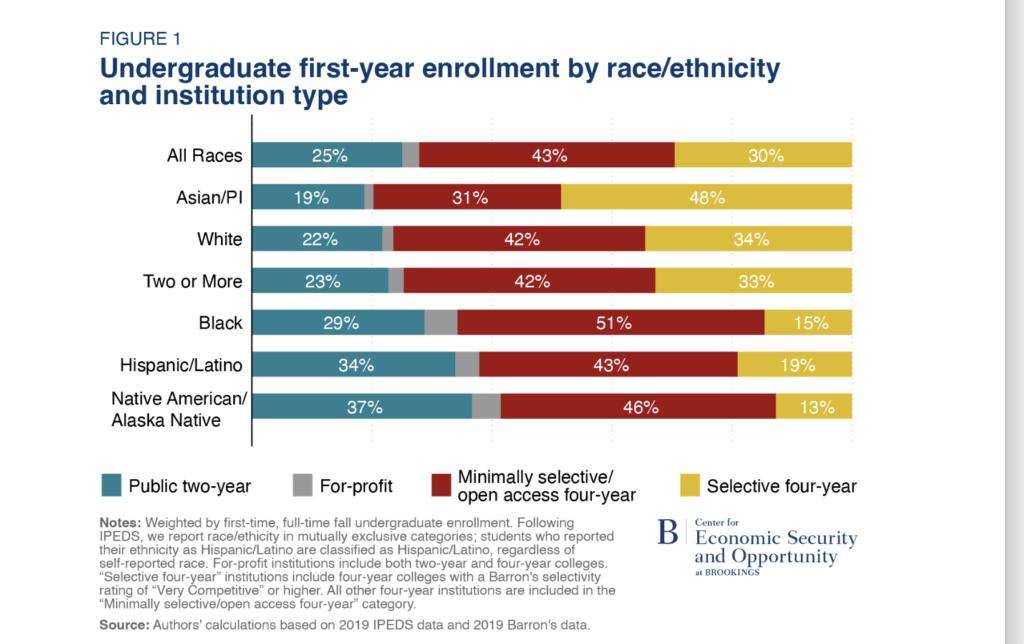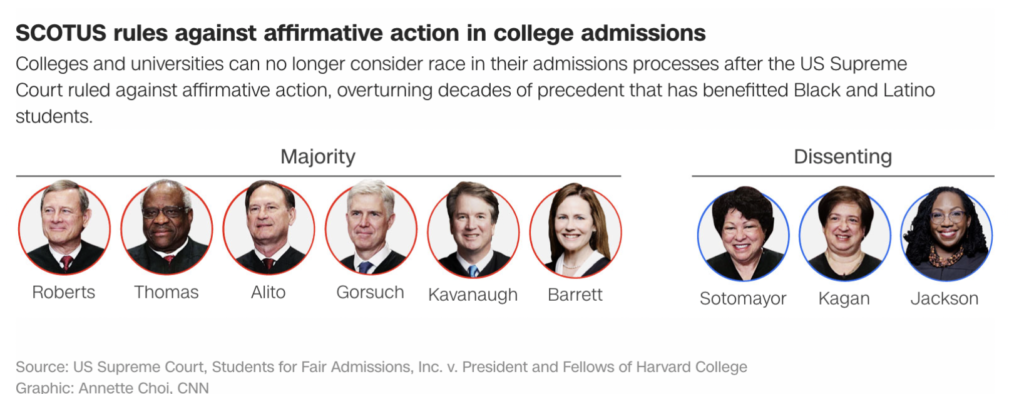For my current event, I selected the Supreme Court’s 2023 SFFA v. Harvard and SFFA v. University of North Carolina decisions reversing race-based college admissions. I debated my topic choice and initially considered evaluating the college campus protests involving the Israel-Hamas war, or the historic pay gap between male and female athletes which has received increased scrutiny following Caitlin Clark’s popularity and the revelation that her WNBA salary is 137 times less than the NBA’s overall first round draft pick. While both of these events appealed to me, I wanted to investigate a less popular issue, at least among teenagers, where I could learn something new and broaden my knowledge. I found the Supreme Court cases intriguing because I was not overly familiar with them or the history underlying the Court’s decisions.
Since I did not have much context for my topic, I started with a broad Google search using the case names themselves as my search terms. I read several straightforward news articles from CNN, Fox News and BBC that summarized the SFFA decisions and the history behind them, before delving into more specific and detailed sources for the assignment. These articles provided high level summaries and some strong quotes from the Supreme Court’s majority and dissenting opinions, while also offering politicians’ and the public’s perspectives on the case. Next, I went to Britannica, which is a site that I am comfortable with and find easy to navigate, and one that provides a reliable, in depth source of credible information. I reviewed several entries on Britannica to grasp a better understanding and overview of the current event as well as the legal precedents leading up to it. I initially read about SFFA v. Harvard and SFFA v. UNC and then reviewed summaries of the key cases preceding them, including Regents of University of California v. Bakke (1978), Grutter v. Bollinger (2003), and Fisher v. University of Texas (2013 and 2016). I also identified an article from University of Orgeon’s Office of the General Counsel which provided a concise summary of SFFA’s precedents that I found very helpful. https://generalcounsel.uoregon.edu/news/fisher-vs-utexas. Through these sources, I learned quickly about the event, its origins and the history surrounding it. I took detailed notes and started an outline for my blog. These readings also increased my interest in the Civil Rights Movement and expanded my understanding of how America’s legacy of racial discrimination through slavery, disenfranchisement and state-mandated segregation influenced affirmative action and SFFA.
After becoming more comfortable with the topic, I searched for Tier 1 and Tier 2 sources. Tier 1 resources are less familiar to me and often denser and more difficult to understand. Referring to the Tier 1 resource chart, I looked up Google Scholar and searched for “the Supreme Court’s 2023 reversal of race-based college admissions.” This search yielded a variety of results. For example, I used the following source, “https://www.researchgate.net/profile/Mohammed-Shehada/publication/375597939_Considerations_of_Race_in_Admissions_-_the_Case_of_SFFA_v_Harvard_University/links/6551eb53b86a1d521bdf95f8/Considerations-of-Race-in-Admissions-the-Case-of-SFFA-v-Harvard-University.pdf” , a 21 page article that I initially skimmed before determining that it provided reliable information. Dated December 14, 2021, the article precedes the 2023 Supreme Court decision and discusses the procedural history of the SFFA v. Harvard case and its uniquely situated Asian American plaintiffs. Next, I checked its credibility. Written by Mohammed Shehada and Dr. Mary McFarland, the paper stems from Georgetown University, a prestigious college. Under the title it lists “School of Continuing Studies MPEA500 – Ethics and Leadership in Higher Education,” which suggests that the piece may have been a research paper or thesis for a class. I researched Dr. McFarland, and her accomplishments reinforced the article’s credibility. She received her BA from the University of Iowa, Masters from the University of Portland and PhD from Gonzaga University. Dr. McFarland co-founded and served as the past President/International Director of Jesuit Worldwide Learning, and has taught in refugee camps housing internationally displaced people in Africa, Asia, and the Middle East. With this information, I continued my review of this article, which provided an interesting discussion of SFFA’s Asian American plaintiffs and their position in America’s racial hierarchy.
Next, I referred back to my search history and clicked on a more recent article written after the Supreme Court’s SFFA decision in the fall of 2023: “https://english.umd.edu/research-innovation/journals/interpolations/fall-2023/race-based-admissions-higher-education”. The article included relevant updates on the Court’s decision as well as a discussion of the history of racial exclusion which underscored the need for affirmative action in the first place. The article summarizes Plessy v. Ferguson’s racially-charged “separate but equal” doctrine and the landmark Brown v. Board of Education ruling which dismantled racial segregation in public schools and paved the way for diversity, equity and inclusion. Authored by Gerald Markey from University of Maryland, a well-regarded institution, Markey interned as a socioeconomic programs assistant and received a BA in government/politics, criminology and criminal justice. This reassured me that the article provided another trustworthy source. While both of these Tier 1 sources include reliable content, they are position papers and offer the respective authors’ personal views on the SFFA cases, so they include certain biases which I factored in when reviewing them.
Then I moved on to Tier 2 and identified .org and and .gov trusted sources. I initially found the following NPR article written by Nina Totenberg and updated on June 29, 2023: “https://www.npr.org/2023/06/29/1181138066/affirmative-action-supreme-court-decision”. As a recent article from an established news organization, I found the article enlightening and reliable. The author, Nina Totenberg, is an American Legal Affairs correspondent who focuses on politics and the Supreme Court. NPR hosts a national network of 950 public radio stations in the United States and generally is perceived as a more middle ground, balanced news network. Yet, 87% of its listeners identify as Democrats, suggesting a certain bias, and, as with other news sources like CNN and BBC, I considered whether the article may be skewed. For example, the title alone suggests an anti-SFFA stance “Supreme Court guts affirmative action, effectively ending race-conscious admissions” (emphasis added). I identified two other Tier two sources which included the 237 page Supreme Court opinion itself, “https://www.supremecourt.gov/opinions/22pdf/20-1199_hgdj.pdf”, as well as an article written by Natasha Warikoo, PhD, for the American Institutes of Research, https://www.air.org/how-did-we-get-here-affirmative-action-admission-selective-colleges
. The Supreme Court Opinion is clearly credible and underlies the event itself, while Warikoo’s article appeared anti-SFFA and pro affirmative action. Written for AIR’s Equity Initiative, Warikoo concludes that SFFA and its progeny will produce a “chilling effect on schools and universities that are trying to promote broad access to elite institutions and creating diverse learning environments for our leaders of tomorrow.” She asserts that the decision will impede marginalized groups’ access to “the American dream.” A former Harvard professor and current sociology professor at Tufts University, Warikoo’s article provides a helpful, if somewhat biased, analysis of SFFA and of the Court’s concerns regarding the anti-Asian American stereotypes that factored into Harvard’s admissions decisions. Warikoo also describes the two key provisions at the heart of the affirmative action challenges, the 14th Amendment’s Equal Protection Clause and Title VI of the Civil Rights Act, and how the cases use laws which were intended to protect minorities to attack race-conscious policies.
Lastly, I referred back to the Tier 3 sources with which I began my research for broader information, including: (1)https://www.britannica.com/topic/Students-for-Fair-Admissions-Inc-v-President-and-Fellows-of-Harvard-College, (2) https://www.bbc.com/news/world-us-canada-65886212, (3)https://www.cnn.com/2023/06/29/politics/affirmative-action-supreme-court-ruling/index.html. The CNN and BBC articles provided easily understandable sources of information, but I remained aware of their potential biases as news outlets which skew towards certain audiences. For example, CNN is notoriously liberal – Republicans previously nicknamed it the Clinton News Network – and only 13% of Americans deem it credible. Yet, it also provides a rich source of 24 hour breaking news content. BBC also suffers from allegations of biased reporting, but is the world’s leading public service broadcasting network. Unlike these somewhat partisan news sources, Britannica, as an encyclopedia, provides credible, fact-checked information compiled by experts. Brittanica strives to remain entirely neutral and objective – a reliable, unbiased resource.
Different media sources portray this event in a diverse manner, with more conservative outlets embracing the decision and more liberal ones chastising it. For example, a June 29, 2023 article from the infamously conservative Fox News emphasizes the benefits of SFFA. In supporting the Court’s affirmative action ban, the Fox article points to the racial stereotyping that negatively impacted Harvard’s Asian applicants, and the racial stigma associated with affirmative action as emphasized by Justice Clarence Thomas. https://www.foxnews.com/politics/supreme-court-rejects-affirmative-action-ruling-universities-using-race-admissions-decisions. Conversely, the NPR and CNN articles’ titles alone suggest a more liberal, pro-affirmative action stance, referring to the Court’s “gut[ting]” of prior decisions. The NPR article alleges that SFFA’s reversal of race-conscious programs in higher education prohibits universities from doing precisely “what most say they still need to do: consider race as one of many factors in deciding which of the qualified applicants is to be admitted.” (Totenberg 2023). The article goes on to highlight Justice Sotomayor’s scathing dissent: “‘The Court subverts the constitutional guarantee of equal protection by further entrenching racial inequality in education, the very foundation of our democratic government and pluralistic society.’” (Totenberg 2023). NPR also notes the dangerous drop in diversity on campuses where state laws ban racial preferences. The CNN article similarly references SFFA’s strong dissenting opinions, quoting Justice Jackson’s harsh critique of the Court’s exclusion of military academies from its ban. Justice Jackson argues that the Court preserves racial diversity in higher education only to the extent that it prepares Black Americans and other marginalized minorities for the “‘bunker’” as opposed to the “‘boardroom.’” (de Vogue, Cole and Sneed 2023). The BBC article further criticizes the Court’s opinion, calling out the justices for ending “positive discrimination.” (Debusmann Jr. 2023). Meanwhile, Britannica and Pew Research provide neutral, straightforward descriptions and data on the topic.
Republicans, like Trump and Pence, “celebrate” the decision, with Trump embracing the Court’s analysis as a “great day” for America, while Democrats “blast” the Court, with Biden and Senate Majority leader Chuck Shumer deeming it a roadblock along the country’s march towards racial justice. (de Vogue, Cole and Sneed 2023; Debussmann Jr. 2023). Public opinion on affirmative action remains similarly mixed along partisan lines.
While I did not dismiss any of my sources, I remained aware of their biases in my review. One gap in the media coverage arises from the perspective of younger people. I would like to read articles describing my peers’ reactions to the decision and how younger generations – with vested interests as soon to be college applicants – view the legal change. Though college applicants may fear voicing their beliefs on such a hotly debated topic, concerned that their opinions will be discounted due to their own personal agendas and unique experiences.



